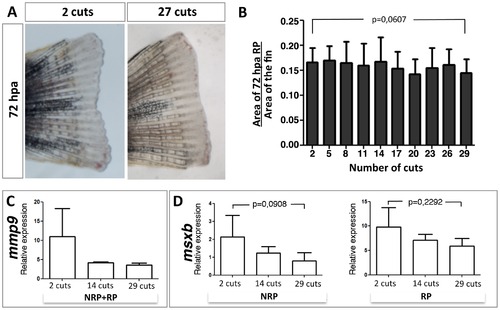- Title
-
The regenerative capacity of the zebrafish caudal fin is not affected by repeated amputations
- Authors
- Azevedo, A.S., Grotek, B., Jacinto, A., Weidinger, G., and Saúde, L.
- Source
- Full text @ PLoS One
|
Consecutive repeated amputations maintain the original size of the fully regenerated caudal fin. (A) The same caudal fin before any amputation (0 cuts) and 4 wpa after 27 consecutive cuts. (B) Area of the 4 wpa regenerated caudal fin with increasing number of cuts. (C) Comparison of the caudal fin area of zebrafish siblings that were amputated 27 consecutive times with age matched siblings that were never amputated. |
|
The 72 hpa regenerate size of the caudal fin is maintained with consecutive repeated amputations over an 11-month period. (A) A 72 hpa caudal fin obtained after the second consecutive amputation and after the twenty-seventh consecutive amputation. (B) Area of the 72 hpa regenerate over the area of the fully regenerated caudal fin immediately before the amputation measured with increasing number of cuts. (C) mmp9 expression levels at 8 hpa with increasing number of cuts. (D) msxb expression levels at 72 hpa in both non-regenerate portions (NRP) and regenerate portions (RP) with increasing number of cuts. |
|
Consecutive repeated amputations affect the structure of non-regenerate bone. Picture of the dorsal lobe of an uncut caudal fin (A) and its age-matched sibling after 27 cuts (B). Picture of the dorsal lobe of an uncut caudal fin (C) and a caudal fin after 7 (D) and 14 cuts (E). Masson′s trichrome staining of longitudinal sections of an uncut bony ray (F) and of an old (G) and regenerated (H) regions of a bony ray after 14 cuts. Confocal images of transverse sections of a Zns5 immunostained proximal region of an uncut caudal fin (I) and of the old (J) and new (K) tissue of a caudal fin after 14 cuts. Quantification of the bone thickness, inter- and intra-ray tissue and fin thickness in the old (L, N, P) and new (M, O, Q). |
|
Repeated inhibition of fin regeneration by interference with Wnt/b-catenin signaling does not diminish regenerative capacity. (A) Schematic illustration of the experimental scheme. Red shaded areas indicate periods in which fish were heat-shocked twice daily, green areas indicate periods in which fish were allowed to regenerate in the absence of heat-shock. amp = amputation, phot = photo of the tail fin. (B) Wild-type and hsp70l:Dkk1-GFP transgenic tail fins heat-shocked until 4 dpa and photographed 7 days after amputation 1 (left column) and photographed after amputation 2 without heat-shocks (right column). Note that heat-shocked wild-type fins regenerated, while Dkk1-GFP expressing fins did not, yet both fins regenerated in the absence of heat-shocks in response to amputation 2. (C) The average regenerate length 7 days post amputation number 2, 4, 6, and 8 were normalized to the length of wild-type fish. Note that there are no significant differences in regenerate length between wild-type and hsp70l:Dkk1-GFP fish. |




